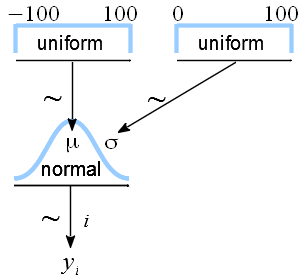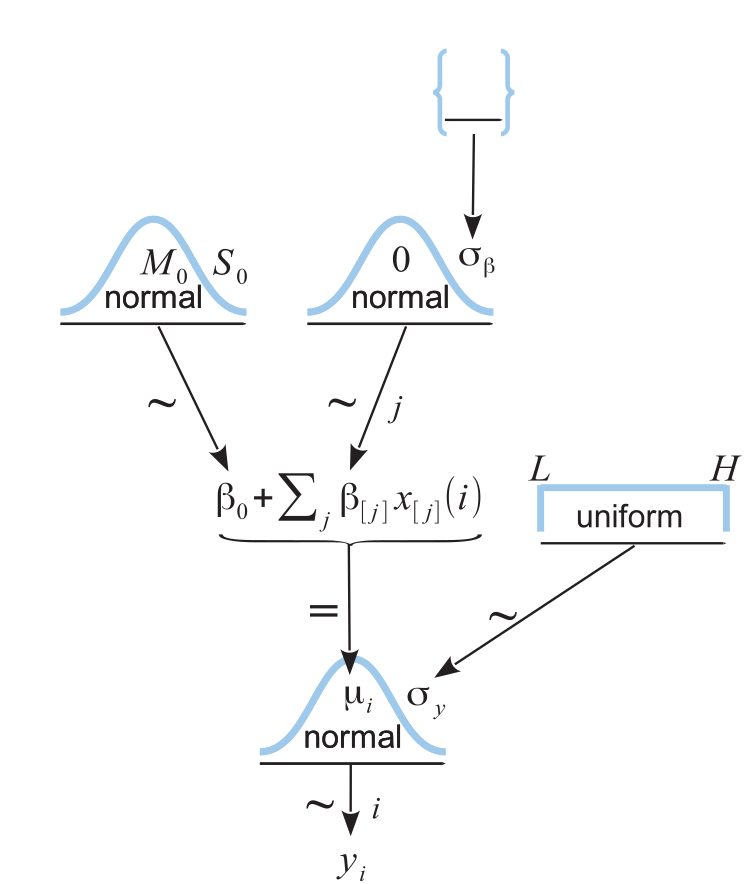Intuition for maximal likelihood or posterior inference
Contents
Intuition for maximal likelihood or posterior inference¶
Simple problem statement¶
Approximate a “parameter” \(\theta\), the average power of a brain signal.
Given:
Some power data \(y_i\), an imperfect realization of this signal
\(\theta\) is normally distributed
Consider:
\(\theta\) has a true value in principle, but it’s inaccessible to us.
The best we can hope to learn is a distribution \(p(\theta)\) of its values.
The peak of this distribution is our best bet.
Note 1: I am leaving out any discussion of priors
Note 2: \(\theta\) has no relationship to any Fourier frequency bands
An analogy¶
Imagine:
You are a hiker on a broad hill of \(\theta\) with no map
You are looking for its peak
What kind of device would be useful?
Some theory¶
Probability distribution for a normal variable is:

That’s the likelihood of \(\theta\) given our data.
Suppose we know \(\sigma\). Can we calculate \(\theta\) for a given \(y_i\)?
Approach 1: Maximum likelihood¶

To find the peak, simply follow “altimeter” up to find maximum likelihood (ML).
What’s at the peak?
That’s how linear mixed effects models are estimated: ML or REML.
Approach 2: Walking around and keeping score (eg Metropolis; used in Bayes)¶
Now imagine:
You are a hiker on a broad hill of \(\theta\) with no map
You are making a map
What kind of devices would be useful?

For each step you take:
Go to a location
Look at the altimeter (plug in data to equation)
Write down altitude (probability) and go to a new location
Ensure you visit every relevant location. One solution: https://chi-feng.github.io/mcmc-demo/app.html?algorithm=HamiltonianMC&target=banana
where:
\(j\) is mouse index
\(i\) is observation index
\(y_i\) is observed power
\(x_i\) is 0 (no stimulation) or 1 (stimulation)
\(\epsilon_i \sim \mathcal{N}(0, \sigma_y^2)\), error
\(\alpha_{j[i]} \sim \mathcal{N}(\mu_{\alpha}, \sigma_{\alpha}^2)\), random intercept
\( \beta \sim \mathcal{N}(?, ?)\) slope. We want to estimate its distribution
Note: this is not a sampling distribution (aka likelihood). We’d have to rearrange terms and substitute \(p(\theta) \sim {\rm exp}(-\frac{1}{2 \sigma^2}(y_i -\sigma)^2)\) for each \( \mathcal{N}(0, \sigma_y^2)\). That’s beyound our scope
Super complicated regression example¶

Complication 2: Integrate prior knowledge¶
Most often, numerical stability reasons and common sense information. For instance:
mountain height cannot be negative
its width is broad but finite
(plus denominator, it’s not strictly relevant)
Say \(p(\theta)\sim \mathcal{N}(0,100)\).
We’ll simply multiply by \(\mathcal{N}(0,100)\) for each step in sampling
